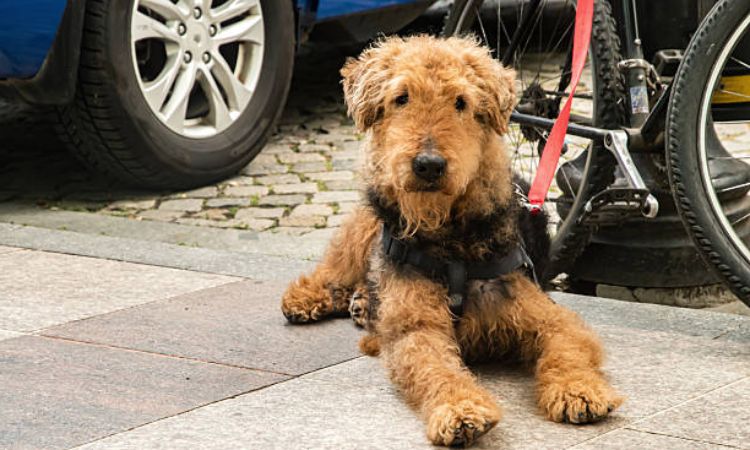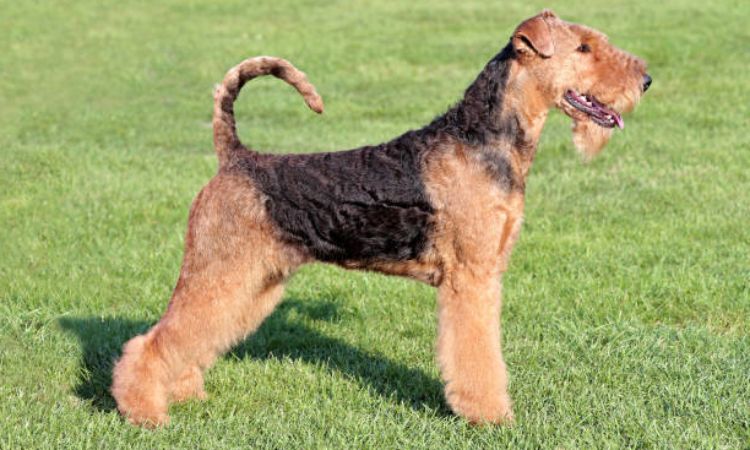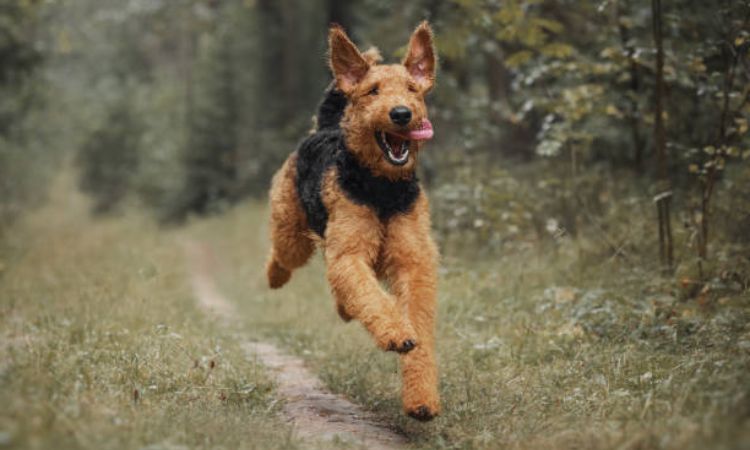The Airedale Terrier, often called the “King of Terriers,” reigns as the largest and one of the most versatile dogs in the terrier family. With a regal presence and a heart full of determination, this breed effortlessly combines athleticism, intelligence, and a loyal spirit.
Whether you’re drawn to their impressive size or their bold personality, the Airedale makes a remarkable companion, ready to tackle everything from outdoor adventures to cozy family moments. But before you welcome this majestic dog into your life, let’s explore what makes the Airedale truly unique its size, temperament, and what you can expect to pay for one of these extraordinary dogs.
History and Origin of the Airedale Terrier
The Airedale Terrier traces its roots to the Aire Valley in Yorkshire, England, specifically along the River Aire. This rugged and scenic region was the birthplace of a breed that would come to be known as the “King of Terriers.” The Airedale was created by crossing the now-extinct Old English Black and Tan Terrier with the Otterhound, two breeds chosen for their versatility, strength, and hunting instincts. Over time, other terrier breeds may have been introduced to perfect the breed’s characteristics. The resulting dog was a medium to large-sized terrier, built for both agility and endurance, with a sharp mind and fearless demeanor.

Originally bred for hunting, the Airedale Terrier was particularly valued for its ability to hunt otters and rats, hence its early nickname, the “Waterside Terrier.” The breed was a highly skilled and versatile working dog, able to work in water and on land, hunting and retrieving small game with efficiency. Their intelligence and stamina made them ideal for farm and working environments.
Beyond hunting, the Airedale was also recognized for its exceptional capabilities in military and police work. During World War I, Airedales served as messenger dogs, carrying messages through the battlefield, often under fire, to deliver crucial communications. Their bravery in these roles earned them a place in history, with tales of their dedication and courage circulating throughout the world. In addition to their military service, Airedales were also employed as police dogs, guard dogs, and even guide dogs, showcasing their adaptability and value in various working capacities. Their history is a testament to their intelligence, loyalty, and ability to perform tasks beyond the expectations of most breeds.
Airedale Terrier Temperament and Personality
The Airedale Personality Profile
The Airedale Terrier is a dog with a commanding presence and a personality that’s just as remarkable. Known as the “King of Terriers,” Airedales are loyal, courageous, and highly intelligent. Their sharp minds make them quick learners, but their independence often gives them an “independent thinker” mentality, meaning they will sometimes choose to follow their own logic over your commands.
At their best, Airedales are affectionate companions who are fiercely protective of their family. Their bravery and natural guard instincts make them excellent watchdogs, always alert to any potential threat. But their playful side balances their more serious traits. Airedales are also known for being the “clown” of the family — with their goofy antics, they have a way of lightening the mood and bringing joy to those around them.
Airedales with Family, Children, and Pets
Airedales can be wonderful family pets, especially when raised with children and other animals from an early age. They’re patient and gentle with kids but need supervision, as their boisterous energy can sometimes overwhelm younger children. Their playful nature makes them a hit in active families, as they’re always up for a game of fetch or a run in the yard.
However, Airedales do have a strong prey drive due to their hunting heritage. They are likely to chase after smaller animals, so compatibility with other pets should be managed carefully. They can get along with other dogs, but their dominant and confident nature means they may not always mesh well with more submissive or timid dogs. Socialization is crucial to ensure they learn to coexist peacefully with other animals in the household.
One of the key challenges in raising an Airedale is managing their independent and stubborn streak. While they are intelligent and can be trained, they can also be willful and difficult at times. Consistency, patience, and positive reinforcement methods are necessary to keep them in line. If they feel ignored or under-stimulated, they may engage in destructive behaviors like digging or chewing, so providing them with mental and physical outlets is essential.
Separation Anxiety and Being Left Alone
Airedales are known for being highly attached to their families, which means they may experience separation anxiety if left alone for long periods of time. Their energetic nature and need for human interaction make them more prone to this condition. If not properly trained, an Airedale may show signs of distress, such as barking, destructive chewing, or attempting to escape.
To address separation anxiety, it’s important to gradually accustom your Airedale to being left alone. Start with short periods of time and increase the duration as they become more comfortable. Offering engaging toys, puzzle feeders, and plenty of exercise before leaving can help reduce anxiety. A well-exercised, mentally stimulated Airedale is less likely to develop destructive behaviors when left alone.

Physical Characteristics: Size and Appearance
Airedale Terrier Size and Growth
The Airedale Terrier, known as the “King of Terriers,” is the largest breed in the terrier group, boasting a muscular, athletic build and a regal stance. Airedales are well-known for their strength, agility, and versatility, making them popular as hunters, athletes, and family companions.
- Male Airedales: Typically stand 23–24 inches (58–61 cm) at the shoulder and weigh 40–50 pounds (18–23 kg).
- Female Airedales: Slightly smaller, standing 22–23 inches (56–58 cm) and weighing 35–40 pounds (16–18 kg).
The “Oorang” Airedale:
Airedales come in a larger variant known as the “Oorang” type, which was originally bred in the early 20th century for even bigger size and strength. Oorang Airedales can grow to 26 inches at the shoulder and exceed 70 pounds in weight. They are rare today but are still occasionally sought after by collectors or those interested in the historical working dog type.
The Classic Wire Coat and Grooming Needs
The Airedale Terrier’s classic wire coat is one of its most iconic features, offering both practical and aesthetic appeal. This dense, wiry, black-and-tan coat is tough and resilient, designed to withstand harsh outdoor conditions. The tan coloration covers the body, legs, and head, while the black saddle typically spans across the back. Some individuals may have a grizzle or mahogany tan color variation.
Coat Texture and Care
- The Airedale’s coat is made up of a double layer—the wiry outer coat and a softer undercoat. This coat helps protect them from the elements and enables them to thrive in a variety of environments.
- Regular grooming is essential to maintaining the coat’s appearance. While they are low-shedding, they still need consistent care to prevent mats and tangles in their wiry fur.
Grooming Requirements
- Brushing: Brushing should be done once or twice a week to remove loose hairs and prevent tangles.
- Professional Grooming: For show dogs, professional hand-stripping (removing dead hair by hand) is necessary to maintain the classic Airedale look. Hand-stripping helps to preserve the wiry texture of the coat, which is highly prized in conformation circles. Pet owners may choose clipping the coat instead, which is easier to maintain and less time-consuming.
- Shedding Level: Airedales are generally considered low-shedding compared to other breeds, thanks to their wiry coat. This makes them a good choice for individuals who are sensitive to dog hair or those with mild allergies.
Airedale Terrier Health and Care Requirements
General Health
Airedales are generally healthy, but prospective owners should be aware of some breed-specific conditions:
- Hip Dysplasia: A genetic condition affecting the hip joints, causing pain, limping, or unusual gait. Early screening and responsible breeding can help reduce risk.
- Bloat (Gastric Dilatation-Volvulus): Large, deep-chested dogs like Airedales are at risk. Symptoms include retching, pacing, distended abdomen, and collapse. Immediate veterinary care is critical.
- Hypothyroidism: A condition where the thyroid produces insufficient hormone, leading to weight gain, hair loss, skin problems, and sluggishness. Lifelong medication can manage the disease.
- Other Concerns: Some Airedales may develop allergies, ear infections, or skin irritation, which can often be managed with preventive care and veterinary guidance.
Typical lifespan: 10–13 years.
Nutrition
Airedales thrive on high-quality, protein-rich dog food suitable for their age and activity level:
- Puppies: Three meals daily until about one year old.
- Adults: Two meals daily.
- Avoid free-feeding to prevent obesity.
- Use slow-feeder bowls and avoid exercise immediately before or after meals to reduce the risk of bloat.
- Supplements, such as fish oil, can help with skin and coat health if recommended by a veterinarian.
Exercise Requirements
Being highly active, Airedales require daily exercise to maintain mental and physical health:
- Walks: At least 40–60 minutes daily.
- Playtime: Fetch, tug, and interactive games.
- Training: Obedience, agility, and mental challenges are ideal.
- Fenced yard: Highly recommended for safe exploration and running.
Grooming
Airedales have a dense, wiry coat that is low-shedding but requires regular upkeep:
- Brushing: Several times per week to prevent mats and tangles.
- Professional Grooming: Hand-stripping for show dogs or clipping 1–2 times per year for pets.
- Bathing: Occasional, no conditioner needed; natural oils keep the coat healthy.
- Ear and Eye Care: Weekly cleaning and trimming around eyes prevent infections or irritation.
Training and Socialization
Airedales are intelligent but independent, requiring consistent, positive reinforcement training:
- Early socialization with children, pets, and strangers is essential.
- Mental stimulation prevents boredom-related behaviors like digging or chewing.
- Positive, engaging training sessions work best; repetitive drills can lead to disinterest.
Preventive Care
Regular veterinary checkups, vaccinations, parasite prevention, dental care, and routine health screenings are key to keeping Airedales healthy throughout their life.

Airedale Terrier Price and Ownership Cost
Initial Cost: Puppy Price vs. Adoption Fee
When it comes to acquiring an Airedale Terrier, the initial cost can vary significantly based on whether you choose to buy a puppy from a breeder or adopt from a rescue.
Airedale Puppy Price (Reputable Breeder):
- The price for an Airedale Terrier puppy from a reputable breeder typically ranges between $800 and $2,000, depending on factors like the breeder’s reputation, the puppy’s pedigree, and your location. Puppies from champion bloodlines or show-quality dogs may cost more, often reaching the upper end of the price range.
- This price generally includes vaccinations, health checks, and pedigree documentation to verify the puppy’s lineage. You should also inquire about the breeder’s health screenings for common issues like hip dysplasia or hypothyroidism.
Adoption/Rescue Fee:
- Adopting an Airedale Terrier through a rescue organization or animal shelter is a more affordable option. Adoption fees usually range from $100 to $300, which often covers vaccinations, spaying/neutering, and basic vet checks.
- Rescued Airedales are often already house-trained and may have some basic socialization, making them a great choice for families seeking a mature dog.
First-Year Costs (One-Time Expenses)
During the first year of ownership, there are several one-time expenses to factor into the cost of bringing your new Airedale Terrier home.
- Crate, Collar, Leash, Food and Water Bowls:
- These essential items typically cost between $150–$300. You’ll want a high-quality crate that’s large enough for your Airedale to grow into, as well as sturdy bowls for food and water, and a comfortable collar and leash for walks.
- Spaying/Neutering and Initial Vaccinations:
- If not already done, spaying or neutering will cost approximately $150–$300, depending on your location.
- Initial vaccinations for your puppy, including rabies, distemper, and parvovirus, can cost between $80 and $120.
- Training Classes:
- Basic puppy training or obedience classes typically cost around $100–$300. Airedales are intelligent but can be independent, so training early on is key to ensuring they become well-mannered, well-behaved companions.

Annual and Recurring Costs
Once your Airedale settles in, ongoing annual and recurring costs are a significant part of ownership. These expenses can vary based on the dog’s size, age, and health status.
- Food Expenses:
- Airedales need a high-quality diet to maintain their energy levels and overall health. Expect to spend around $40–$60 per month for premium dog food, which equates to $480–$720 per year.
- Routine Veterinary Care/Preventative Medications (Flea/Tick/Heartworm):
- Regular vet check-ups, vaccinations, and preventative medications for common issues like flea, tick, and heartworm are essential for maintaining your dog’s health. These expenses typically cost between $100–$300 per year.
- Some owners may also choose additional health screenings as the dog ages, especially for hip dysplasia, which can add to the cost.
- Professional Grooming:
- Airedales have a dense, wiry coat that requires regular maintenance. Professional grooming is recommended every 2–3 months, which typically costs between $50–$70 per session, totaling $300–$500 per year. Alternatively, if you’re comfortable with at-home grooming, you can do it yourself, though it may take more time and effort.
- Pet Insurance (Optional but Recommended):
- Pet insurance can help mitigate the costs of unexpected medical expenses. On average, expect to pay around $25–$60 per month for a comprehensive plan that covers accidents, illnesses, and sometimes routine care. This could total $300–$720 annually.
Estimated Lifetime Cost of an Airedale
The lifetime cost of owning an Airedale Terrier, considering their lifespan of 10–12 years, is estimated to range from $12,000 to $16,000. This includes:
- Initial purchase or adoption cost (either from a breeder or rescue)
- Annual recurring costs like food, grooming, vet care, and insurance
- One-time expenses such as spaying/neutering, training, and equipment
Taking into account these costs, owning an Airedale is an investment in both time and money, but their loyalty, intelligence, and playful nature make them a rewarding companion for any family.
An Airedale Terrier is a smart, loyal, and energetic companion. Owning one requires planning for initial costs, regular grooming, healthcare, and exercise. With proper care and training, they become a devoted and versatile family member for years to come.






